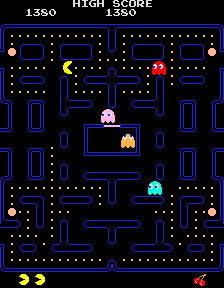 The Game: As a round yellow creature consisting of a mouth and nothing else, you maneuver around a relatively simple maze, gobbling small dots (10 points) and evading four colorful monsters who can eat you on contact. In four corners of the screen, large flashing dots (50 points) enable you to turn the tables and eat the monsters for a brief period for an escalating score (200, 400, 800 and 1600 points). Periodically, assorted items appear near the center of the maze, and you can consume these for additional points as well. The monsters, once eaten, return to their home base in ghost form and return to chase you anew. If cleared of dots, the maze refills and the game starts again, but just a little bit faster… (Deluxe, 1981)
The Game: As a round yellow creature consisting of a mouth and nothing else, you maneuver around a relatively simple maze, gobbling small dots (10 points) and evading four colorful monsters who can eat you on contact. In four corners of the screen, large flashing dots (50 points) enable you to turn the tables and eat the monsters for a brief period for an escalating score (200, 400, 800 and 1600 points). Periodically, assorted items appear near the center of the maze, and you can consume these for additional points as well. The monsters, once eaten, return to their home base in ghost form and return to chase you anew. If cleared of dots, the maze refills and the game starts again, but just a little bit faster… (Deluxe, 1981)
Memories: Journey back with us now to the first two years of the eighties, when Pac-Man ruled the coin-op video game roost, where arcade owners’ demand for the prized Pac-Man machines was high, where players’ skill at winning was increasing and their repeat business was proportionately dwindling, and everyone wanted a piece of that little yellow pie.
In one of the most blatant instances of arcade piracy, no less than three manufacturers procured Pac-Man circuit boards, copied and reprogrammed them, and began marketing altered Pac-Man clones to make a quick buck from beleaguered arcade owners around the world. (It’s worth noting that many of these pirate manufacturers were shut down and sued out of existence by Bally/Midway and Namco.)
 Puck-Man – not to be confused with the original Japanese name of Pac-Man – was probably the least altered of the Pac-Clones, changing only a few basic parts of the maze and adding two additional side tunnels, an innovation which was later made official in Ms. Pac-Man.
Puck-Man – not to be confused with the original Japanese name of Pac-Man – was probably the least altered of the Pac-Clones, changing only a few basic parts of the maze and adding two additional side tunnels, an innovation which was later made official in Ms. Pac-Man.
